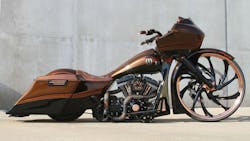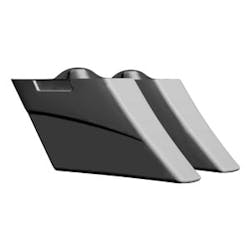Laser Scanning Speeds Conversion of Moldings to Diecastings
Motorcycle enthusiasts comprise a sort of subculture defined by the technology, aesthetics, and terminology of their prized machines, an affinity group that is highly engaged, dynamic, and obviously mobile. They also represent a significant commercial market, one that supports designers, manufacturers, fabricators, and retailers who maintain and advance the machines that are the center of their attention.
Misfit Industries in Plano, Tex., is one of those enterprises. It manufactures and supplies customized parts Harley-Davidson touring models, known as “baggers.” Its high-concept designs are engineered to fits, creating radical machines that will attract attention, most importantly the attention of other enthusiasts. But, the need for speed and technology is just as important in a specialty market, as Misfit learned recently.
In the past, Misfit built most of its parts in fiberglass, manually laying composite fibers on a mold, spreading resin over the fibers, forming the part, and finishing it to specification. Of course, this was all very labor-intensive (the process could take six to eight weeks for some parts) and many customers did not want to wait.
NVision Inc. helped Misfit Industries reduce the time and production cost for bringing a new series of Harley-Davidson custom parts to market. Recently, the fabricator converted a number of its custom parts from composite materials to diecast aluminum and steel in order to reduce labor costs, and lead-time. NVision’s scanning and CAD modeling services helped it to reverse-engineer the previous generation of its own parts, factory parts, and sections of motorcycles that interface with the parts. The resulting CAD models were provided to a diemaker, which provided Misfit with the hard tools necessary to continue its production routines.
NVision develops non-contact optical measurement devices and provides related services for reverse engineering and inspection. It also offers contract-scanning, in particular for aerospace, power generation, and oil-and-gas industry customers.
For Misfit, the CAD conversion effort ensured that each custom part it produces now and in the future will match seamlessly with previous and new generations of Harley-Davidson motorcycles.
Substantial Cost Reductions
“By switching to diecast steel and aluminum for these parts we have substantially reduced lead-time and production costs,” explained Misfit Industries president Chris Eder. “However, making the change required that we re-design our entire product line.
“We needed precise CAD models of each of our parts to provide to the company that builds the dies. Often, those CAD models were not available,” he said. “Using conventional engineering methods to create them would have been very expensive and time-consuming. We also ran the risk that the final parts might not fit perfectly, an unwelcome scenario that would have required expensive repairs to the dies.”
Once Misfit contacted NVision, its engineers performed laser scanning on the interfacing sections of a motorcycle and on the previous generation of parts. For example, to re-design fenders NVision scanned a factory-supplied fender to identify the exact position of its mounting holes. They also scanned the wheel to derive its true horizontal and vertical radius.
Next they scanned the previous-generation Misfit fender in order to obtain its specific styling and geometry. Then, the engineers converted the data collected by scanning into surface models.
Finally, the three surface models were combined into an assembly, to create a new fender design that mated perfectly to the frame and matched the existing Misfit design.
“Our engineering team reviewed and polished the final designs and provided them to a supplier who built the dies to produce the parts,” Eder said.
“The new parts provide a perfect fit and are considerably less expensive and time-consuming to manufacture than the previous generation,” he continued. “The key to the success in this application was using NVision’s engineering services to quickly and accurately reverse engineer the motorcycle, factory parts and our own previous-generation parts.”


